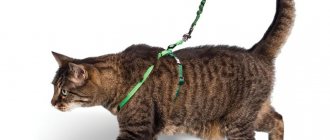Any domestic cat benefits from walks in the fresh air. But not every owner is able to let a cat outside, because it may not return home. The optimal solution to the problem would be to leave the house with your pet on a harness and leash. The cat walks under the control of the owner, in safety, and can move freely, sniff, observe events happening around and chew grass. A harness and leash are useful not only when going for a walk, but also when visiting a veterinary clinic or a cat show, allowing you to let the animal out of the carrier without any risk. All that remains is to choose the right harness, and also to accustom the freedom-loving and proud animal to it.
- 2 We put a harness on the cat
- 3 How to put on a figure-eight harness
3.1 Video: how to properly put on a figure-eight harness
- 4.1 Full back harness
- 5.1 Step-by-step instructions
5.1.1 Video: how to put on an H-harness
What is this?
The whole structure consists of thin straps intertwined with each other. These are two closed rings encircling the animal’s body in the area of the neck, tummy and converging at the shoulder blades. Many designs have dividing tape between the forelimbs. Look also at the examples of cat harnesses in the photo.
The product can be equipped with drawstrings that help regulate the tightness of the fit. There is also a carabiner in the area of the shoulder blades for attaching a leash. This arrangement is important for mustachios - their necks are more fragile than those of dogs.
DIY cat harness. Step-by-step instruction
Option No. 1. Jeans harness
It is better to use a jeans belt. But you can also take pant panels.
- Measurements are taken from the kitten. To do this, make a girth around the neck, as well as under the chest of the kitten. When measuring, insert your index finger under the measurement so that the future harness does not pinch the animal. Make an allowance of 0.5 centimeters on both sides.
- Cut the strips according to the measurements. To connect two strips together, a third element is cut.
- The parts are sewn together by hand using short stitches. The thread is selected in accordance with those used to sew the jeans.
- The two harnesses are connected to each other by jumpers. Sewn on.
- They cut the leash. Its width should be at least 3-5 centimeters. The optimal length for walking is 1.5 – 1.8 meters.
- A button is installed on the edge of the leash, and a rivet is placed 6-7 centimeters closer to the center of the leash. Having passed through the jumper, the leash is secured using a button and a rivet.
INTERESTING TO KNOW: DIY knitted cat house
The leash for walking is ready. A denim leash will add variety to your pet's wardrobe.
DIY cat harness. Option No 2
Necessary materials:
- Thin leather straps. You can use a flat nylon rope.
- Buckles.
- Rings.
- Carbine.
- Thick needle.
- Scissors.
- Awl.
- Strong threads.
The design is created in the form of two belts covering the pet’s neck and body. They are connected to each other by a special strip. A leash is attached to the jumper or one of the straps. The design is secured with a buckle and carabiner.
- Measurements are taken from the animal. Neck and chest measurements are taken.
- Cut off two pieces of the strap, making allowances of 2 centimeters. The third piece is needed to create a jumper bar.
- Cut off 1.5 - 1.9 meters of the strap. This will be a DIY cat leash. A carabiner is attached to one end, the other is bent in the form of a loop, into which the owner’s free hand can enter. The loop is stitched.
- If a flat rope is used instead of a strap, its ends are burned with fire.
Option No 3
Necessary materials:
- A piece of raincoat fabric.
- Fleece fabric.
- Rubber.
- Strap.
- Braid.
- Decorating ribbon.
- Lock.
- Fastening elements.
- Decor.
- Roulette.
Instructions:
- A sketch is drawn on a piece of notebook paper. You can draw the parameters for the finished accessory.
- The pattern is transferred to raincoat fabric and fleece.
- The place for the braid is marked on the fabric and stitched.
- A braid is attached along the spine and a loop is left. A ring is threaded through it. It is needed to secure the leash.
- The neck is made from raincoat fabric. An elastic band is sewn onto it, collecting the fabric. You can use braid for decoration.
- The neck is attached to the base. The edge is folded. During sewing, it is necessary to try on whether the design will put pressure on the animal.
- Assemble the fastening parts. Straps are inserted inside, attached, the edges are processed and stitched. The product is put on the cat to adjust the length of the belt.
- Decorate the base. The product is decorated with bows, stones, rhinestones - to your taste. Braid and decorative tape are attached along the edges.
- The harness is put on the pet. The leash is attached to the ring.
INTERESTING TO KNOW: How and with what to wash a cat’s eyes
Why do you need a harness?
The most important reason to buy a cat harness is to ensure the safety of the animal. By taking or releasing a purr outside, we sometimes expose our pet to mortal dangers - infections, other animals, inappropriate behavior of some people. A simple harness will help protect against this - the cat will not go far away from you, it will always be within your field of vision, and you will be able to protect it if something happens.
In addition, a pet that loves to walk on its own will not run away from its owner while wearing a harness and will not have to search for it in vain. This leash also makes it more convenient to transport the animal to the country house, to exhibitions, to the veterinarian, etc.
First experiments
Experienced owners recommend doing the following: take the cat outside in a carrier bag so that there is an opportunity to explore the environment from a “safe distance.” And only then provide the opportunity to walk on a leash. This is how the owner will be able to study the behavior of his cat outside his usual apartment and accurately determine whether the pet needs regular trips outside.
Having chosen the most suitable area, the pet is carefully lowered to the ground. Don’t be distracted by your phone or conversations with friends, control every step and surroundings, because at any moment a stranger or a dog without a leash may appear. Give the cat the opportunity to satisfy its curiosity, do not pull it away from every bush (such actions can cause injury to the animal).
Make sure that your household does not pick up anything from the ground. Do not let him near the carcasses of small rodents or birds. Avoid contact with other cats, which may provoke aggression. Don't let it go too far.
The first walk should not last longer than 10-15 minutes. Only in the future is it possible to increase the time to 30-40 minutes, when the purr adapts to new conditions. Individuals on their own determine the duration of their travel.
And at the dacha you can without a leash
When should you start training your cat to wear a harness?
The most optimal age is 2-3 months. Kittens quickly get used to everything new, perceiving it as a necessary attribute of their life. I must say that their adaptation process is much faster.
But there is nothing difficult if you want to accustom an adult animal to a harness. It will only take a little more time and patience - yours and the cat's.
How to choose a good harness?
First you need to choose a suitable harness for cats:
- The best material for the product is nylon or cotton. But leather harnesses are too stiff for cats - they are better used for dogs.
- Make sure that the item has a soft felt pad on the side where it will come into contact with the fur and skin of the animal.
- Buy only a product that is adjustable with straps or drawstrings.
- Be sure to try your purchase on the animal (we’ll look at how to put a harness on a cat with step-by-step photos below). There should be a distance of no more than two of your fingers between the straps and the animal’s body.
- The most suitable strap width is 1.5 cm.
- A leash is included with the body mount (the harness itself). It is best to choose options with a length of about 2 m. If possible, purchase a leash tape measure.
- All fastenings should be light, with a comfortable fastener - not too tight, but not loose.
- If you plan to regularly walk your animal, then it is worth purchasing two types of cat harnesses. For the warm season - the usual cotton or nylon straps. For the winter - a harness-overall, which will additionally warm your pet in the cold season.
How to wear a harness with a solid back or chest
Vest harnesses and overall harnesses are the easiest to put on because they resemble human clothing and are put on in a similar way. The difference between the models is the location of the solid fabric - on the back or on the chest.
The overall harness usually does not have straps and is fastened with Velcro. This harness is more expensive than all other options, but it is practically not felt on the body and is suitable for sensitive cats who do not want to get used to harnesses.
Harness-overalls are more suitable for the cold season
Full back harness
On the solid back of the vest there is a ring for attaching a leash, and the fasteners are located below: one, usually on the pet’s neck, and the second on the stomach, between the front and hind legs. It's easy to put on:
- Place a solid piece of cloth on the back of the animal so that the leash attachment is at the withers.
- Place your left paw into the left hole, your right paw into the right.
- Fasten the fasteners on the neck and stomach.
- Check whether the vest is too tight: two fingers should fit between the fabric and the cat’s body.
- Attach the leash to the loop on your back.
A common and comfortable type of harness for cats, which is also easy to put on.
Full breast harness
Such vests are less common, but they are even easier to wear. One-piece fabric is located on the chest and stomach, and fasteners are on the back.
- Place the whole cloth on the cat's belly.
- Place your left paw into the left hole and your right paw into the right hole.
- Connect the two parts of the vest at the back and secure with a clasp.
- Check the tension of the straps: they should not be too tight around the animal’s body.
- Place the leash on the mount.
A type of harness that is rarer for cats, more often used for small dogs
Types of harnesses
Today the following samples are presented in pet stores:
- "Eight". These are two rings of straps connected to each other by a jumper on the shoulder blades, to which the leash is attached.
- H-shaped model. The same “figure eight”, only with an additional jumper between the front legs.
- V-shaped model. Forms the outline of a given Latin letter on the animal’s chest with straps.
- Overalls. Similar to a suit, but with an additional leash on a carbine. This model is the easiest to put on, it is impossible to get out of it, and it is perfect for animals with sensitive skin. There is only one minus - in the summer a cat will be very hot in overalls.
Preparation
We have discussed all aspects that require special attention. Now we begin to prepare for the walk itself.
Vaccination and treatment against parasites
Pets cannot be taken outside without vaccinations. Even a strong immune system cannot cope with serious diseases. Unfortunately, many owners believe that their place of residence is safe, which means they don’t have to spend money on things like vaccinations and anthelmintic drugs. However, just walking on the grass, a cat can pick up fleas, ticks and even helminths!
Warning! By ignoring vaccination and treatment against parasites, the owner jeopardizes not only the health of the animal, but also the health of his family members. Our little brothers can contract many dangerous diseases if they are not given routine vaccinations.
Residents of the southern regions should be especially attentive to the issue of vaccination. The tropical climate (or rather, high levels of humidity) is a favorable environment for various viruses and bacteria, for example, leptospira, which causes leptospirosis. If the owner plans to spend a vacation by the sea, taking the cat with him, it is necessary to check with the veterinarian what additional vaccinations may be needed.
Collar
Cat collars serve a certain practical purpose. For example, this is a necessary accessory at exhibitions or while walking. You can hang an address tag on the attribute in case your pet gets lost. Reflective collars help you find your pet in the dark.
What types can be found on pet store shelves:
- with GPS navigator;
- with a bell and other decorations;
- decorative (for exhibitions and photo shoots);
- antiparasitic.
Walking a cat on a leash and harness
Leash
In urban conditions, walking a cat is strictly on a leash. Walking with a cat is completely different from going outside with a dog.
To control all movements you need a strong leash. Without it, the owner will not be able to provide his household with a safe stay on the street outside the home.
This accessory is not necessary if the pet lives in a private sector and has constant access to the street, i.e. prefers to walk on his own.
Harness
Purebred individuals regularly attend regional and international exhibitions. For the safety of transportation and control of the pet, ammunition is purchased.
A harness is the best option for both outdoor walks and long trips. With its help, the owner can control the cat. Few mustachioed purrs know commands and do not run away from their owner in search of adventure.
What makes the accessory unique? It is made of special thin straps that wrap around the body behind the shoulder blades and have a fastener at the level of the back/chest. At the same time, the design does not create uncomfortable sensations and does not provoke a stressful state.
Let's look at the harness models:
- in the form of a vest (mesh material allows the skin to breathe);
- with an additional strap at neck level (considered the most reliable);
- standard (straps).
How to properly put a harness on a cat?
Don't worry - the procedure will only be confusing for you the first time. Next, you will get used to putting the harness on your pet quickly and almost automatically.
So, how to put an H-shaped harness on a cat:
- First of all, unfasten the leash from her. Otherwise, he will simply disturb you and get confused.
- Find the first closed ring on the device. You need to put it on the cat’s neck so that the carabiners are at the level of the back. If there is a strap that will pass between the front legs, then it should be at chest level.
- Then place a second closed ring around the animal’s neck.
- Stretch the first along the body through the front legs to the cat’s tummy. It is important to make sure that the paws are each on their own side of the strap separating them.
- As a result of these actions, one ring of the harness will be just below the animal’s neck, and the second will be on the tummy. There is a dividing strap on the chest between the legs.
- Did you manage? The hardest part is over. Now, using puffs and carabiners, adjust the tightness of the harness around the cat’s body. Tighten if the straps are loose. Otherwise, if the harness squeezes the body and interferes with movements, move the straps apart a little.
- The last step is to fasten the previously removed leash with a carabiner. That's all!
The “Eight” is much easier to put on - the cat’s front paws are threaded into its rings, like into sleeves. The connection with the carabiner is held above the back.
The video below will also show you how to put on the harness quickly and correctly.
Types of leashes for cats
The purpose is the same, however, depending on the activity, build, and character of the pet, owners are recommended to choose the appropriate harness.
Main types of harnesses with photos:
- "Eight". It looks like two loops of different sizes: one for the neck, one for the body. They are connected using a carabiner; in the middle there is a mount for a leash. This product is the most difficult to get out of, but it also poses a danger for active pets: the ring on the neck can crush it with sudden movement. Choose a leash wisely, only if the character of the four-legged dog allows you to walk with such equipment.
Figure-of-eight harness for walking cats
- "Y-shaped". Repeats the figure-of-eight device (the straps are connected in one place), but with a jumper on the chest.
Y-shaped harness for walking cats
- "V-shaped". When expanded, it looks like a rhombus or two triangles with a common base. The clasp closes on the back.
V-shaped harness for walking cats
- "H-shaped". There are also two loops, but here each is snapped onto the body with a carabiner. They are connected to each other by a third strap. This option is recommended for active animals; the harness fits tightly enough to the body, but does not cause pain during sudden movements.
H-shaped harness for walking cats
- Harness-vest. Suitable for hairless breeds or wool breeds in colder periods, as it is an item of clothing. Covers the body to the waist in length, has a ring for attaching a leash. Cats are free-spirited animals, most of them will not like so much fabric on their body. They will definitely try to get out of the vest. Before choosing this type of ammunition for a long period, check that your pet will calmly accept the new thing.
Harness-vest for walking cats
When purchasing, be sure to check the strength of the carabiners. Fastenings should not unbend, unfasten, or bend under normal pressure. Suitable material for year-round walking is plastic, and metal for warm seasons.
In addition to the harness, you can purchase a separate leash. It is always better if it can be unfastened from the harness, because this makes it possible to let the cat go without it, while still having the option to fasten it back in case of danger. Proven options are a cable tape measure or a belt tape measure. This device gives the four-legged freedom of movement. It always extends to the required distance, which softens the pet’s jerks or fixes the length, allowing the owner to keep his little friend at a certain distance. The average length is 2 meters. However, if you wish, you can find leashes of different lengths for different walking purposes.
For walking cats, a removable leash is recommended, as well as metal or durable plastic fasteners.
How to accustom a cat to a harness?
For an animal, the device you put on it is a cause for great stress. Naturally, if it spends some time in stupor, shock, it will try to remove the harness from itself. Therefore, before going out into the world, you must wear the harness several times at home so that the animal gets used to it. Never drag your cat by the leash! Let her build her own routes in new “clothes.”
To help your pet get used to the harness faster, we recommend that you adhere to the following recommendations:
- Don't wear your purchase right away. Place it on the floor and let the cat sniff it.
- After a couple of days, you can start training fitting. Do not forget to speak calmly to the animal, caress it, and do not make sudden movements that cause discomfort.
- It is better to try on before eating. You can simply thank your cat for her patience with her favorite treat. This way she will associate the harness with something pleasant.
- Do not leave your pet in a harness at home alone! It should always be under your supervision.
- Try to show the cat that there is nothing wrong with her new “clothes” - play with her, invite her to run and walk around.
- You should begin to control the direction of your cat’s movements only when it begins to feel comfortable in the harness.
- The first places to walk are quiet, deserted, without animals.
- Don't think that you can teach your cat to run after you on a leash like a dog. Unfortunately, this won’t work with a purr. Be prepared that on walks you will follow the cat, and not vice versa.
Now you know which harness is best to choose for your pet and how easy it is to put it on. We advise you to approach the cat with understanding, taking into account its fear and bewilderment in front of a new object.
Main rules
For convenience, I have compiled a list of universal tips that will help you painlessly accustom your pet to an unusual accessory.
- Give your cat a chance to get used to the new thing. I left the strap in sight and gave it time to sniff.
- Always follow the instructions.
- If the cat resists, do not try to force it or yell at it. Let go, calm down and try again after a while.
- Getting used to the strap is stressful for the animal, so go outside only after making sure that the cat is calm and ready for a walk.
- Make the first 2-3 exits in a quiet and safe place, where there are no loud noises or dogs.
- Give your cat a treat when you dress him to make the process an enjoyable experience.
- Two fingers should fit freely between the harness and the cat's body. Use this method to check if your straps are too tight.











